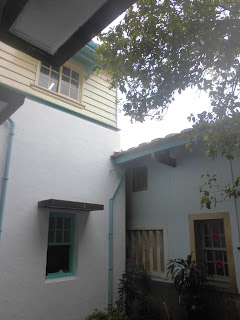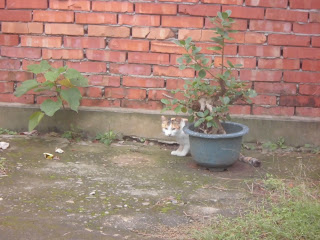10/10的放假我又去北部玩。10月放假第一天跟9月的放假一樣我租機車在新竹縣飆風。這次我要介紹新竹縣的新埔鎮一下。
也跟上次一樣,我在國翔機車租車。我有租過商店當中,它一定是最好的。我建議你也去這裡租。老闆的服務有客氣,車子的情況很好,再說因為老闆請大家先加滿再還車所以租出時候,車子是滿油你不用馬上找加油站。(按照我的經驗來說,很多租車店的車子,租出時油差不多都沒有。我覺得這樣很麻煩。)
We had two three-day weekends back at the end of September and beginning of October. I went up north for both of these weekends. I've already posted some stuff I saw during the first trip, so today I'm going to introduce some stuff from the second one. I spent the first day driving around Hsinchu Prefecture. These photos are from a small town called Xinpu, which I have chosen to spell Shinbu in the title of this post just to be difficult. Actually, check out the link above and laugh at the fact that the place is labeled "Xinpu, Hsinchu", utilizing two different romanization systems (and not even entirely consistently at that) at once in its name. It's especially funny because both the "Xin" in "Xinpu" and the "Hsin" in "Hsinchu" are actually the exact same Chinese character. Ahh, Taiwanese romanizations!
I rented a scooter from the same place as I had in the previous trip north to Hsinchu and Miaoli, Gwoshiang Scooters, just a little ways from Hsinchu station. I'm plugging them here because they are far and away the best scooter rental place I have yet to use in Taiwan. The scooters are in good shape, the people in the store are nice, and they actually have a policy of returning the scooters with a full tank, meaning that unlike every other place I've been too, I didn't have to immediately go searching for a gas station upon renting the scooter. (Seriously, why isn't this standard in Taiwan?)
9月下旬にも10月上旬にも連休があった。私はもう9月の連休についてポストしたけど、今日は10月の連休に行ったところを紹介しようと。1日目は新竹県でドライブした。下の写真は全部「新埔」という町で撮ったものだ。今ウィキペディアで見て気づいたけど、日本語の読み方がすごいことになっている。ちょっとうふふっと笑った。
9月の連休と同じく、国翔でバイクをレンタルした。ここはお勧め。店員がフレンドリーで、バイクの状況がよくて、後台湾では珍しい「返す前に満タンにする」という決まりがあるので、バイク借りてすぐガソリンスタンドを探す様な面倒臭いことはない。(意外と台湾では満タンにして返す店が少ない。バイクを借りたら、タンクがほぼ空になっているのは普通だ。)
新埔鎮離新竹市不遠,可是氣氛不太一樣。感覺起來很鄉下的地方。鎮裡有蠻多老家,很適合逛逛街。第一張照片是名叫「桂花園」的飯館。這個建築是日本時代蓋的。有日式,華式,洋式的因素所以很特別。
Shinbu is not too far away from Hsinchu City, but it's pretty rural feeling regardless. There are also a surprising number of interesting, old buildings there too. Let's start with this one, built during the Japanese period, that contains a mix of Japanese, Chinese and western architectural elements. It's a restaurant, so you can walk inside and check it out too if you want. The name is "Gway Hwa Yuen". (桂花園)
新埔が新竹市からそんなに遠くないのに、結構田舎になっている。古くて面白い建物がたくさんあって、散策するにはすごくいいところだと思う。まずは日本時代に建てられた建物見よう。この建物は現在「桂花園」というレストランになっているので、中に入って参観もできる。建物のデザインには日式、中華式、それに洋式の要素が見える。
在裡面有兩張「賞狀」。是紀念學年念完的事情。一張是昭和20年(1945年)的所以是日代最後的學年。隔年中華民國政府已經開始統治台灣。
These two plaques were on display inside the restaurant. They're school-year completion plaques for the local elementary school from the year "Showa 20" for the top one and "Showa 19" for the bottom one. (1945 and 1944 in real years that the world outside of Japan actually uses.) The top plaque would have been among the last ones given out by this school system seeing as in 1946, Taiwan was no longer Japanese.
中に入ってみたら、この賞状が展示されていた。上の方は戦争の最後の年だから、最後に配られた賞状の一つだ。翌年の昭和21年、台湾はすでに日本じゃなくなっていた。
飯館裡的廣場
An open courtyard inside the building.
レストランの中の様子
外面的樣子
And here it is from across the street.
外から見た。
在桂花園對面有一座廟。這天沒開,所以我只好站在門外拍照。
Across the street from the restaurant was this temple, which was unfortunately closed on the day I was there. I didn't even know that temples did close.
桂花園の向こうに廟があった。残念ながら、この日は公開していないので、外からの写真しか撮っていない。
Across the street from the restaurant was this temple, which was unfortunately closed on the day I was there. I didn't even know that temples did close.
桂花園の向こうに廟があった。残念ながら、この日は公開していないので、外からの写真しか撮っていない。
濕濕的貓腳跡
Wet cat feet
濡れた猫の足跡
商店街的商店大部分都關門。有可能是因為我2:00左右到了這裡。大家都在休息嗎?
There's a neat covered shopping arcade in the town. It was the early afternoon break time when I got there, so almost no stores were open.
昔ながらの商店街があったが、店がほとんど閉まっていた。昼過ぎだったから、おそらくみんな昼休みしていた。
我看到這棟閩南式房子去那裡看看,,,
I went to check out this traditional house...
伝統的な民家を見に行って、、、
發現一隻貓!
...and discovered a cat...
そして猫を発見した。
追貓就到了很不可思議的門。好像進去就到夢世界。
...who took me through this mystical gate to dreamland!
その猫に夢界に招いでもらった。
可是我沒去夢界。就是因為我還在這個現實世界上有很多事我要做。
...which it turns out is just like our world except that they call "Monday" "Sprokkleyok".
しかし、私はまだこの世にはすることが残っているんだ。夢界に行くのはまだ早い。
我通過門,到了廢墟的房子。
After going through the gate above, the alley continued until a dead end where there was this perhaps abandoned home.
門を通って、細い道を歩き続けたら、廃墟となった様な家を発見した。
又發現貓!
Another cat!
また猫が登場した。
鄰旁有廟
A temple next door
お隣の廟
再一棟廢房
And another abandoned looking building.
この建物も廃墟の様だった。
加紅看看:
Extra red version
プラス赤バージョン
查網路,好像這個「紫氣」從「紫氣東來」來了。也像是跟老子有關的說法。
The plaque above the door translates to something like "purple air". It comes from an old saying related to Lao-Tzu and has something to do with good omens.
「紫気」は老子と関係があっていい兆しという意味があるそうだ。
夢界再叫我來來。
In dreamland again.
また夢界にちょっと入ってみたけど、結局地球に戻った。
回去我才注意到這些小小的花朵。
On the way back out of the alley I noticed these little flowers.
出ようとしたら可愛い花に気づいた。
回家看照片我才注意到再花下有小小的千足蟲。
There's also a millipede below the flowers, which I didn't notice until I was going through the photos at home.
花の下にちっちゃいムカデがおる。
電線桿下有奇怪的機器。我不知道是什麼東西。
Some weird thing placed under a telephone pole.
電柱の下にこの変な機械があった。
馬路通過一樓的房子。
A building with a street passing under it.
道路が建物の下を通るから面白い。
下次還有啊!
More next time!
また次回ね!




































































